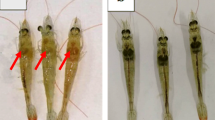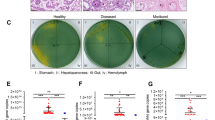Abstract
Vibrio parahaemolyticus (V. parahaemolyticus) caused huge diseases and economic losses in shrimp aquaculture. Understanding the infection mechanism might help develop new strategies for controlling pathogen outbreak. Redistribution of trace element homeostasis, accompanied by impairment of antioxidant status and immune response, was observed during various infections. Accordingly, we hypothesized that V. parahaemolyticus infection might influence trace element homeostasis, impair antioxidant function, and induce inflammation response in shrimp. In the present study, the aim of this study was to investigate the influence of V. parahaemolyticus infection on trace element homeostasis, antioxidant status, and inflammation response in Litopenaeus vannamei (L. vannamei). The results showed that compared with the control group, V. parahaemolyticus infection significantly increased (P < 0.05) intestinal V. parahaemolyticus number, serum copper (Cu) concentration at 24, 48, and 72 h and significantly increased (P < 0.05) serum zinc (Zn), iron (Fe), and manganese (Mn) concentrations at 24 h but decreased (P < 0.05) at 72 h. The intestinal gene expressions of metal transporters ZIP13, CTR1, and MT1 were significantly decreased at 24, 48, and 72 h, and DMT1 was significantly decreased at 48 h and 72 h in the infection group. The activities of superoxide dismutase (SOD) and glutathione peroxidase (GPx) were suppressed at 48 h and 72 h, and the malondialdehyde (MDA) content was increased at 24, 48, and 72 h in the infection group; the pro-inflammatory genes including necrosis factor-α (TNF-α), lipopolysaccharide-induced TNF-α factor (LITAF), and Ras-related protein Rab6A (RAB6A) were significantly upregulated at 48 and 72 h in the infection group. These results suggest that V. parahaemolyticus infection influenced trace element homeostasis, impaired antioxidant function, and induced inflammation response in L. vannamei, which might help understand the infection mechanism. The results provide a better understanding of the L. vannamei and V. parahaemolyticus interactions and may deliver the basis for further research in preventing the bacterial diseases.





Similar content being viewed by others
References
Li EC, Xu C, Wang XD, Wang SF, Zhao Q, Zhang ML, Qin JG, Chen LQ (2018) Gut microbiota and its modulation for healthy farming of Pacific white shrimp Litopenaeus vannamei. Rev Fish Sci Aquac 26(3):381–399. https://doi.org/10.1080/23308249.2018.1440530
Karunasagar I, Ababouch L (2012) Shrimp viral diseases, import risk assessment and international trade. Indian J Virol 23(2):141–148. https://doi.org/10.1007/s13337-012-0081-4
Thitamadee S, Prachumwat A, Srisala J, Jaroenlak P, Salachan PV, Sritunyalucksana K, Flegel TW, Itsathitphaisarn O (2016) Review of current disease threats for cultivated penaeid shrimp in Asia. Aquaculture 452:69–87. https://doi.org/10.1016/j.aquaculture.2015.10.028
Prachumwat A, Taengchaiyaphum S, Mungkongwongsiri N, Aldama-Cano DJ, Flegel TW, Sritunyalucksana K (2019) Update on early mortality syndrome/acute hepatopancreatic necrosis disease by April 2018. J World Aquacult Soc 50(1):5–17. https://doi.org/10.1111/jwas.12559
Tran L, Nunan L, Redman RM, Mohney LL, Pantoja CR, Fitzsimmons K, Lightner DV (2013) Determination of the infectious nature of the agent of acute hepatopancreatic necrosis syndrome affecting penaeid shrimp. Dis Aquat Org 105(1):45–55. https://doi.org/10.3354/dao02621
Hood MI, Skaar EP (2012) Nutritional immunity: transition metals at the pathogen-host interface. Nat Rev Microbiol 10(8):525–537. https://doi.org/10.1038/nrmicro2836
Becker KW, Skaar EP (2014) Metal limitation and toxicity at the interface between host and pathogen. FEMS Microbiol Rev 38(6):1235–1249. https://doi.org/10.1111/1574-6976.12087
Palmer LD, Skaar EP (2016) Transition metals and virulence in bacteria. Annu Rev Genet 50:67–91. https://doi.org/10.1146/annurev-genet-120215-035146
Skrypnik K, Suliburska J (2018) Association between the gut microbiota and mineral metabolism. J Sci Food Agr 98(7):2449–2460. https://doi.org/10.1002/jsfa.8724
Davison KM (2017) Mineral nutrients: from macro-level to ultra trace:261–272. https://doi.org/10.1007/978-3-319-49929-1_26
Tarifeno-Saldivia E, Aguilar A, Contreras D, Mercado L, Morales-Lange B, Marquez K, Henriquez A, Riquelme-Vidal C, Boltana S (2018) Iron overload is associated with oxidative stress and nutritional immunity during viral infection in fish. Front Immunol 9:1296. https://doi.org/10.3389/fimmu.2018.01296
Agay D, Anderson RA, Sandre C, Bryden NA, Alonso A, Roussel AM, Chancerelle Y (2005) Alterations of antioxidant trace elements (Zn, Se, Cu) and related metallo-enzymes in plasma and tissues following burn injury in rats. Burns 31(3):366–371. https://doi.org/10.1016/j.burns.2004.11.010
Singh M, Yadav P, Sharma A, Garg VK, Mittal D (2017) Estimation of mineral and trace element profile in bubaline milk affected with subclinical mastitis. Biol Trace Elem Res 176(2):305–310. https://doi.org/10.1007/s12011-016-0842-9
Qi C, Wang L, Liu M, Jiang K, Wang M, Zhao W, Wang B (2017) Transcriptomic and morphological analyses of Litopenaeus vannamei intestinal barrier in response to Vibrio paraheamolyticus infection reveals immune response signatures and structural disruption. Fish Shellfish Immun 70:437–450. https://doi.org/10.1016/j.fsi.2017.09.004
Peng HH, Liu YJ, Ojcius DM, Lee CM, Chen RH, Huang PR, Martel J, Young JD (2017) Mineral particles stimulate innate immunity through neutrophil extracellular traps containing HMGB1. Sci Rep 7(1):16628–16616. https://doi.org/10.1038/s41598-017-16778-4
Skaar EP, Raffatellu M (2015) Metals in infectious diseases and nutritional immunity. Metallomics 7(6):926–928. https://doi.org/10.1039/c5mt90021b
Alpert PT (2017) The role of vitamins and minerals on the immune system. Home Health Care Manag Pract 29(3):199–202. https://doi.org/10.1177/1084822317713300
Ji PF, Yao CL, Wang ZY (2011) Reactive oxygen system plays an important role in shrimp Litopenaeus vannamei defense against Vibrio parahaemolyticus and WSSV infection. Dis Aquat Org 96(1):9–20. https://doi.org/10.3354/dao02373
Ighodaro OM, Akinloye OA (2019) First line defence antioxidants-superoxide dismutase (SOD), catalase (CAT) and glutathione peroxidase (GPX): their fundamental role in the entire antioxidant defence grid. Alexandria J Med 54(4):287–293. https://doi.org/10.1016/j.ajme.2017.09.001
Tyagi A, Saravanan V, Karunasagar I, Karunasagar I (2009) Detection of Vibrio parahaemolyticus in tropical shellfish by SYBR green real-time PCR and evaluation of three enrichment media. Int J Food Microbiol 129(2):124–130. https://doi.org/10.1016/j.ijfoodmicro.2008.11.006
Xu Z, Wang Y, Gul Y, Li Q, Song J, Hu M (2020) Effects of copper supplement on the immune function and blood-chemistry in adult Chinese horseshoe crab Tachypleus tridentatus. Aquaculture 515:734576. https://doi.org/10.1016/j.aquaculture.2019.734576
Geng WY, Yao FJ, Tang T, Shi SS (2019) Evaluation of the expression stability of beta-actin under bacterial infection in Macrobrachium nipponense. Mol Biol Rep 46(1):309–315. https://doi.org/10.1007/s11033-018-4473-4
Middleton JR, Luby CD, Viera L, Tyler JW, Casteel S (2004) Short communication: influence of Staphylococcus aureus intramammary infection on serum copper, zinc, and iron concentrations. J Dairy Sci 87(4):976–979. https://doi.org/10.3168/jds.S0022-0302(04)73242-7
Erskine RJ, Bartlett PC (1993) Serum concentrations of copper, iron, and zinc during Escherichia coli-induced mastitis. J Dairy Sci 76(2):408–413. https://doi.org/10.3168/jds.S0022-0302(93)77360-9
Esmaeilnejad B, Tavassoli M, Asri-Rezaei S, Dalir-Naghadeh B, Malekinejad H, Jalilzadeh-Amin G, Arjmand J, Golabi M, Hajipour N (2014) Evaluation of antioxidant status, oxidative stress and serum trace mineral levels associated with Babesia ovis parasitemia in sheep. Vet Parasitol 205(1–2):38–45. https://doi.org/10.1016/j.vetpar.2014.07.005
Chandrangsu P, Rensing C, Helmann JD (2017) Metal homeostasis and resistance in bacteria. Nat Rev Microbiol 15(6):338–350. https://doi.org/10.1038/nrmicro.2017.15
Kramer U, Talke IN, Hanikenne M (2007) Transition metal transport. FEBS Lett 581(12):2263–2272. https://doi.org/10.1016/j.febslet.2007.04.010
Wolff NA, Garrick MD, Zhao L, Garrick LM, Ghio AJ, Thevenod F (2018) A role for divalent metal transporter (DMT1) in mitochondrial uptake of iron and manganese. Sci Rep 8(1):211. https://doi.org/10.1038/s41598-017-18584-4
Jeong J, Eide DJ (2013) The SLC39 family of zinc transporters. Mol Asp Med 34(2–3):612–619. https://doi.org/10.1016/j.mam.2012.05.011
Pierson H, Yang H, Lutsenko S (2019) Copper transport and disease: what can we learn from organoids? Annu Rev Nutr 39:75–94. https://doi.org/10.1146/annurev-nutr-082018-124242
Krezel A, Maret W (2017) The functions of metamorphic metallothioneins in zinc and copper metabolism. Int J Mol Sci 18(6). https://doi.org/10.3390/ijms18061237
Qin Z, Babu VS, Wan Q, Zhou M, Liang R, Muhammad A, Zhao L, Li J, Lan J, Lin L (2018) Transcriptome analysis of Pacific white shrimp (Litopenaeus vannamei) challenged by Vibrio parahaemolyticus reveals unique immune-related genes. Fish Shellfish Immun 77:164–174. https://doi.org/10.1016/j.fsi.2018.03.030
Chari N, Felix L, Davoodbasha M, Sulaiman Ali A, Nooruddin T (2017) In vitro and in vivo antibiofilm effect of copper nanoparticles against aquaculture pathogens. Biocatal Agric Biotechnol 10:336–341. https://doi.org/10.1016/j.bcab.2017.04.013
Ertan P, Yereli K, Kurto O, Balcioglu IC, Onag A (2002) Serological levels of zinc, copper and iron elements among Giardia lamblia infected children in Turkey. Ped Int 44:286–288. https://doi.org/10.1046/j.1442-200x.2002.01550.x
Shi B, Wang T, Zeng Z, Zhou L, You W, Ke C (2019) The role of copper and zinc accumulation in defense against bacterial pathogen in the Fujian oyster (Crassostrea angulata). Fish Shellfish Immun 92:72–82. https://doi.org/10.1016/j.fsi.2019.05.049
Duan YF, Zhang JS, Dong HB, Wang Y, Liu QS, Li H (2015) Oxidative stress response of the black tiger shrimp Penaeus monodon to Vibrio parahaemolyticus challenge. Fish Shellfish Immun 46(2):354–365. https://doi.org/10.1016/j.fsi.2015.06.032
Zhao X, Duan X, Wang Z, Zhang W, Li Y, Jin C, Xiong J, Li C (2017) Comparative transcriptome analysis of Sinonovacula constricta in gills and hepatopancreas in response to Vibrio parahaemolyticus infection. Fish Shellfish Immun 67:523–535. https://doi.org/10.1016/j.fsi.2017.06.040
Dragun Z, Filipovic Marijic V, Krasnici N, Ramani S, Valic D, Rebok K, Kostov V, Jordanova M, Erk M (2017) Malondialdehyde concentrations in the intestine and gills of Vardar chub (Squalius vardarensis Karaman) as indicator of lipid peroxidation. Environ Sci Pollut R 24(20):16917–16926. https://doi.org/10.1007/s11356-017-9305-x
Irshad M, Chaudhuri PS (2002) Oxidant-antioxidant system: role and significance in human body. Indian J Exp Biol 40(11):1233–1239
Vural H, Demirin H, Kara Y, Eren I, Delibas N (2010) Alterations of plasma magnesium, copper, zinc, iron and selenium concentrations and some related erythrocyte antioxidant enzyme activities in patients with Alzheimer’s disease. J Trace Elem Med Bio 24(3):169–173. https://doi.org/10.1016/j.jtemb.2010.02.002
Muthukrishnan S, Defoirdt T, Ina-Salwany MY, Yusoff FM, Shariff M, Ismail SI, Natrah I (2019) Vibrio parahaemolyticus and Vibrio harveyi causing acute hepatopancreatic necrosis disease (AHPND) in Penaeus vannamei (Boone, 1931) isolated from malaysian shrimp ponds. Aquaculture 511:734227. https://doi.org/10.1016/j.aquaculture.2019.734227
Ahmmed S, Khan MA, Eshik MME, Punom NJ, Islam A, Rahman MS (2019) Genomic and evolutionary features of two AHPND positive Vibrio parahaemolyticus strains isolated from shrimp (Penaeus monodon) of south-west Bangladesh. BMC Microbiol 19(1):270–214. https://doi.org/10.1186/s12866-019-1655-8
Hong XP, Xu D, Zhuo Y, Liu HQ, Lu LQ (2016) Identification and pathogenicity of Vibrio parahaemolyticus isolates and immune responses of Penaeus (Litopenaeus) vannamei (Boone). J Fish Dis 39(9):1085–1097. https://doi.org/10.1111/jfd.12441
He WQ, Rahimnejad S, Wang L, Song K, Lu KL, Zhang CX (2017) Effects of organic acids and essential oils blend on growth, gut microbiota, immune response and disease resistance of Pacific white shrimp (Litopenaeus vannamei) against Vibrio parahaemolyticus. Fish Shellfish Immun 70:164–173. https://doi.org/10.1016/j.fsi.2017.09.007
Li XL, Wang L, Zhang CX, Rahimnejad S, Song K, Yuan XL (2018) Effects of supplementing low-molecular-weight fish hydrolysate in high soybean meal diets on growth, antioxidant activity and non-specific immune response of Pacific white shrimp (Litopenaeus vannamei). Turk J Fish Aquat Sc 18(5):717–727. https://doi.org/10.4194/1303-2712-v18_5_07
Soonthornchai W, Rungrassamee W, Karoonuthaisiri N, Jarayabhand P, Klinbunga S, Soderhall K, Jiravanichpaisal P (2010) Expression of immune-related genes in the digestive organ of shrimp, Penaeus monodon, after an oral infection by Vibrio harveyi. Dev Comp Immunol 34(1):19–28. https://doi.org/10.1016/j.dci.2009.07.007
Zhang Z, Wu H, Xiao J, Wang Q, Liu Q, Zhang Y (2013) Immune responses evoked by infection with Vibrio anguillarum in zebrafish bath-vaccinated with a live attenuated strain. Vet Immunol Immunop 154(3–4):138–144. https://doi.org/10.1016/j.vetimm.2013.05.012
Funding
This research was supported by the National Key R&D Program of China (2018YFD0900400).
Author information
Authors and Affiliations
Corresponding author
Ethics declarations
Conflict of Interest
The authors declare that they have no competing interests.
Additional information
Publisher’s Note
Springer Nature remains neutral with regard to jurisdictional claims in published maps and institutional affiliations.
Rights and permissions
About this article
Cite this article
Jiao, L., Dai, T., Zhong, S. et al. Vibrio parahaemolyticus Infection Influenced Trace Element Homeostasis, Impaired Antioxidant Function, and Induced Inflammation Response in Litopenaeus vannamei. Biol Trace Elem Res 199, 329–337 (2021). https://doi.org/10.1007/s12011-020-02120-z
Received:
Accepted:
Published:
Issue Date:
DOI: https://doi.org/10.1007/s12011-020-02120-z




